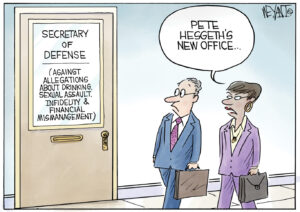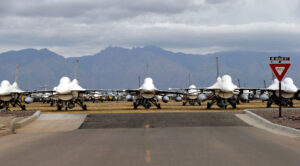The U.S. Intelligence Community’s New Year’s Wish
Every few years, the intelligence community's “center for long-term strategic analysis” has been intent on producing a document it calls serially Global Trends [fill in the future year]. The latest edition, out just in time for Barack Obama’s second term, is Global Trends 2030.
By Tom Engelhardt, TomDispatchThis piece originally appeared at TomDispatch.
Think of it as a simple formula: if you’ve been hired (and paid handsomely) to protect what is, you’re going to be congenitally ill-equipped to imagine what might be. And yet the urge not just to know the contours of the future, but to plant the Stars and Stripes in that future has had the U.S. Intelligence Community (IC) in its grip since the mid-1990s. That was the moment when it first occurred to some in Washington that U.S. power might be capable of controlling just about everything worth the bother globally for, if not an eternity, then long enough to make the future American property.
Ever since, every few years the National Intelligence Council (NIC), the IC’s “center for long-term strategic analysis,” has been intent on producing a document it calls serially Global Trends [fill in the future year]. The latest edition, out just in time for Barack Obama’s second term, is Global Trends 2030. Here’s one utterly predictable thing about it: it’s bigger and more elaborate than Global Trends 2025. And here’s a prediction that, hard as it is to get anything right about the future, has a 99.9% chance of being accurate: when Global Trends 2035 comes out, it’ll be bigger and more elaborate yet. It’ll cost more and still, like its predecessor, offer a hem for every haw, a hedge for every faintly bold possibility, a trap-door escape from any prediction that might not stick.
None of this should be surprising. In recent years, with a $75 billion collective budget, the IC, that historically unprecedented labyrinth of 17 intelligence agencies and outfits, has been one of Washington’s major growth industries. In return for almost unfettered funding and a more-than-decade-long expansion of its powers, it’s promised one thing to the American people: safety, especially from “terrorism.” As part of a national security complex that has benefitted enormously from a post-9/11 lockdown of the country and the creation of a permanent war state, it also suffers from the classic bureaucratic disease of bloat.
So no one should be shocked to discover that its forays into an anxiety-producing future, which started relatively modestly in 1997, have turned into ever more massive operations. In this fifth iteration of the series, the authors have given birth to a book-length paean to the future and its dangers.
For this, they convened groups of “experts” in too many American universities to count, consulted too many individual academics to name despite pages of acknowledgements, and held “meetings on the initial draft in close to 20 countries.” In other words, a monumental effort was made to mount the future and reassure Washington that, while a “relative economic decline vis-à-vis the rising states is inevitable,” the coming decades might still prove an American plaything (even if shared, to some extent, with China and those rising powers).
Frack Is the New Crack
Having grown to immodest size, the “trends” in the project’s title were no longer faintly enough. Instead, the language of Global Trends 2030 has bloated to match its mammoth pretensions. These days to nail down the future for American policymakers, you need Megatrends (“Individual Empowerment,” “Diffusion of Power”), Game-Changers (“Crisis-Prone Global Economy,” “Governance Gap,” “Potential for Increased Violence”), Black Swans (“Severe Pandemic,” “Much More Rapid Climate Change,” “A Reformed Iran”), and Tectonic Shifts (“Growth of the Global Middle Class,” “Unprecedented and Widespread Aging”), not to speak of Potential Worlds or fictional futuristic scenarios in which those Megatrends, Game-Changers, Black Swans, and Tectonic Shifts mix and match into possible futures.
Out of this, what exactly have the mavens of American intelligence, the representatives of the last remaining global superpower, concluded? Here would be my partial summary: that we should expect the rise of nothing much we don’t already know about; that various versions of the knowable present can be accurately projected into the future; that much depends on what happens to the Earth’s greatest state (with China nipping at its heels) — whether, that is, with its “preponderance across the board in most dimensions of power, both ‘hard’ and ‘soft,’” the U.S. will remain a benevolent “global security provider” or “global policeman” of planetary stability or — disaster of disasters — pull in on itself, creating a declinist fortress America; that the true American crisis might be a decrease in military spending; that odds are the global economy, with more than a billion new “middle class” consumers, could do marginally better or worse; that Iran might (or might not) build nuclear weapons; that global conflict could increase somewhat (with an emphasis on resource wars) — or decline; that the national state could hang in there with something like its present power or lose some of it to nongovernmental bodies and “smart cities,” and so on.
There are, however, a few topics that seem to have gone MIA in the National Intelligence Council’s version of our future world. You won’t, for instance, find these words emphasized in Global Trends 2030: corporations — they seem to have no role worth mentioning in the world of the future; depression — yes, “recession,” or even in extremis “collapse,” but not “global depression,” not even when the U.S. is compared to the planet’s previous great imperial power, nineteenth century Britain, and so to an era when depressions were rife (a possible “great depression” gets a single “low probability” mention); imperial — since we’re the only… ahem… great you-know-what left, that’s not an appropriate word for the world of 2030; revolution — oh, there was one of those in 1848 and it can be mentioned, but despite the fact that the globe has been convulsed by unexpected uprisings and unforeseen movements in recent years, in 2030, revolution is unimaginable; capitalism — no need even to say it in a world in which nothing else exists, and to use it might imply that by 2030 another system of any sort could arise to challenge it, which is, of course, inconceivable; Israeli nuclear weapons — why bring up the Israeli nuclear arsenal, which actually exists and will assumedly be there in 2030, when you can focus on that fabulous black swan Iran and its (as yet) nonexistent nuclear arsenal.
Finally, military base — undoubtedly a perfectly acceptable term for the NIC in Global Trends 2040, once the Chinese establish a few of them abroad. In the meantime, in a world in which the U.S. still has about 1,000 of them globally, there’s no point in bringing the subject up or discussing the fate of Washington’s historically unprecedented garrisoning of the planet. Nor in Global Trends 2030 will you find a serious consideration of American military power or Washington’s penchant in recent years not for guaranteeing stability but ensuring instability, mayhem, and chaos in distant lands.
You’ll find a section on drones, but not on our drone wars and how they might play out in 2030. (Another verboten set of words now associated with those wars are assassination, targeted killing, kill list. You’ll find the Arab Spring discussed in passing, but not the Indian Spring. (You know, the one that occurred in 2023 in that youth-bulge of a nation when rising expectations met economic frustration.) You’ll read much about resource problems and potential resource wars, but not about the 800-pound gorilla in the global room. The single looming crisis threatening the well-being of the planet, climate change, while certainly discussed in passing, is essentially ducked on the grounds, it seems, that by 2030 it won’t really have hit yet. (Assumedly, none of the group meetings the NIC called were held in the parched U.S. southwest, the drought-stricken Midwest, or on the Jersey Coast since Hurricane Sandy hit.)
You’ll note that the thing that makes our intelligence futurologists jump for joy and gives them the equivalent of a drug high is hydraulic fracturing, or fracking, to which they return again and again. I kid you not. For them, frack is the new crack and if this document (god save us) were ever made into a movie, it might be called Frack to the Future. Yes, in most of their future scenarios, fracking, releasing all that “extreme energy,” makes the U.S. energy independent, a natural gas exporter, and practically ensures that 2030 will once again be an American year! Yippee!
Time’s Democracy
Above all, the National Intelligence Council’s analysts have managed to largely banish the single most essential, unavoidable, and bracing aspect of the future: surprise. That tells you far more about the Washington world the authors inhabit than what may happen in 2030. But before I get to that, give me just a second to pat myself on the back.
After all, I’ve done you an enormous favor. I’ve actually read Global Trends 2030 from its two-page “dear reader” letter from the chairman of the NIC and the report’s “executive summary” though its 136 two-columned pages, and even its interminable acknowledgements. And let me assure you, it’s put together by perfectly intelligent people and has some interesting nuggets in it. The assembled crew has even tried its hand at writing bits of futuristic fiction and at least one of them, a “Marxist” analysis “updated” for the twenty-first century, has some passing entertainment value.
In the end, though, the document, like the IC itself, is an overblown artifact of Washington’s own limitations and fears. It’s also mind-numbingly, bone-blisteringly dull and repetitive, featuring elaborate charts laying out what you’ve just read as if you were simply too thick to take it in paragraph by paragraph. It’s exactly the sort of thing that no bureaucratic collective should be allowed to inflict on the great unknown, and that no one raised on H.G. Wells, Arthur Clarke, Isaac Asimov, Ray Bradbury, Philip Dick, Ursula Le Guin, George Orwell, William Gibson, or for that matter, Suzanne Collins should ever have to endure.
And yet, the strangeness of this project, historically speaking, should get your attention. Stop for a moment and think about time and the state. States have traditionally had an urge to control the past (sometimes working hard to gain a monopoly on the writing of history). And — no surprise here — most states have the urge to control the present. But the future? The future is time’s democracy. No government can secure it. No military can invade it. No intelligence agency can embed its operatives in it.
This is why the Global Trends series that originally emerged from the increasingly self-confident world of the “sole superpower” holds a certain fascination. It represents a unique state foray into the future, a singular attempt to corral and possess it. Once upon a time, the distant future was the province of utopian or dystopian thinkers, pulp fiction writers, oddballs, visionaries, even cranks, but not government intelligence services. Peering into it was, at its best, a movingly strange individual adventure of the imagination, whether you were reading Edward Bellamy or Charlotte Perkins Gilman, Yevgeny Zamyatin or H.G. Wells, George Orwell or Aldous Huxley.
That was, of course, before the Pentagon began planning for the weaponry of 2020, 2035, and 2050; before war turned nuclear and so, with the exception of two cities in 1945, could only be “fought” in think tanks via futuristic scenario writing. It was before the leaders of the sole superpower were so overcome by hubris that they began to suspect the future, like the present, might indeed be theirs.
And yet the future is, and remains, everyone’s, always. Until it actually comes to pass, your guess is as good as the CIA’s or the NIC’s. Probably better. They may, in fact, be the worst possible candidates to write about the future. Even when they know the rap against them — as laid out in Global Trends 2030, their inability to let go of “continuities” for “discontinuities and crises” — it doesn’t matter.
They simply can’t bring themselves to think outside the box. They don’t dare surprise themselves, no less give the future its surprising due, even though — my own guess — ours is likely to be a world increasingly filled with those discontinuities. The rise of China, the collapse of Lehman Brothers, the Arab Spring, the eruption of both the Tea Party and the Occupy Movement, even the tiniest of unexpected trapdoors in history — like Paula Broadwell taking down America’s “greatest” general — are conceptually beyond them. Surprise is their poison. They would prefer to palm a few cards and play from the bottom of the deck rather than acknowledge that the future just isn’t theirs.
Apocalypse When?
The early years of the George W. Bush era proved a visionary, if quite mad, moment. That was when Washington blew a hole in the oil heartlands of the planet and may have launched the Arab Spring. More recently, policymaking has been firmly restored to an administration of managers and the American imperial imagination, such as it was, began to atrophy. Global Trends 2030 reflects that all-American reality, which is why it’s less like entering the future than getting a guided tour of the airless corridors of Washington’s collective mind as 2013 begins.
Of course, the future is an impossibly tricky thing to guide anyone through. Take China, for example. No one would claim its rise isn’t a fact of world historical importance. Still, I think it would be fair to say that, from the beginning of the nineteenth century to the end of the twentieth, an individual who accurately predicted the next bizarre and spectacular twist in China’s path to the future would have been laughed out of any roomful of experts: the collapse of imperial China, the improbable rise of Mao Zedong’s communist movement out of the chaos of invasion and civil war, or — most improbable of all — the creation by China’s Communist Party, after a decade of startling radicalism and extremism, of an unprecedented capitalist powerhouse (slated, as Global Trends 2030 points out, to pass the U.S. as the globe’s leading economy by 2030, if not earlier).
So why should anyone imagine that, when it comes to China, present trends can simply be extrapolated into the future? And yet so it goes for the folks of Global Trends 2030, who project a more daring than usual series of scenarios for that country, ranging from cooperation with the U.S. in hegemonic regional harmony to growing nationalism and “adventurism” abroad to (an extreme improbability, as they see it) an economic “collapse” scenario that shocks the global economy.
Still, let’s take one prominent fact of Chinese history, which the analysts of the National Intelligence Council ignore (although China’s leaders are deeply aware of it or they wouldn’t have moved to suppress the Falun Gong sect or, more recently, a Christian cult of the Mayan apocalypse). Under stress, China has a unique revolutionary tradition. For at least a couple of thousand years, in bad times huge peasant rebellions, often fed by syncretic religious cults, have swept out of the Chinese interior to threaten the country: the Yellow Turbans, the White Lotus, the Taipings of the mid-nineteenth century, and most recently Mao’s own movement, among others.
Already today, in economically upbeat times, China has tens of thousands of “mass incidents” a year in which citizens protest polluting factories, peasants take over local villages, and so on. If the Chinese economy takes a major hit between now and 2030, amid growing economic corruption and increasing inequality, who knows what might actually happen?
With the rarest of exceptions, however, the authors of Global Trends 2030 relegate the shock of the future to outlier “black swans” like a pandemic that could kill millions or solar geomagnetic storms that knock out satellite systems and the global electric grid (a scenario the writers of NBC’s hit show Revolution got to well ahead of the NIC’s experts). Otherwise, when it comes to a truly disjunctive world, for better or worse, forget it in Global Trends 2030.
I don’t think I’m atypical and yet I can imagine worse than they seem capable of describing without even blinking, starting with a full-scale, gob-smack global depression. In fact, if you have an apocalyptic turn of mind, all you need to do is look at the information they supply — some of which their analysts consider good news — and it’s easy enough to grasp what a truly extreme world we may be entering.
They tell us, for instance, that “the world has consumed more food than it has produced in seven of the last eight years” (a trend they hope will be reversed by the genetic modification of food crops); that water is running short (“by 2030 nearly half the world’s population will live in areas with severe water stress”); that demand for energy will rise by about 50% in the coming 15 to 20 years; and that greenhouse gases, entering the atmosphere as if there were no tomorrow, are expected to double by mid-century. By their estimate, in 2030 there will be 8.3 billion high-end omnivores rattling around this planet and more than a billion of them, possibly two billion, will have entered some abysmally degraded version of “the middle class.” That is, there will be more car drivers, more meat-eaters, more product buyers.
Throw in climate change — and the “success” of fracking in keeping us on a fossil fuels diet for decades to come — and tell me you can’t imagine the odd apocalyptic scenario or two, and a few shocking surprises as well.
A Wishing Well on the Global Mall
Think of Global Trends 2030 as a portrait of an aging, overweight Intelligence Community (and the academic hangers-on who work with them) incapable of seeing the world as it is, let alone as it might be. The National Intelligence Council evidently never met an apocalypt or a dreamer it didn’t want to avoid. Its movers and shakers seemingly never considered putting together a panel of sci-fi writers, and in all their travels they evidently never stopped in Uruguay and paid a visit to the radical writer Eduardo Galeano, or even consulted his 1998 book Upside Down: A Primer for the Looking-Glass World.
At one point, discussing global consumerism — and remember this was the year after the first Global Trends report came out — he wrote:
“Consumer society is a booby trap. Those at the controls feign ignorance, but anybody with eyes in his head can see that the great majority of people necessarily must consume not much, very little, or nothing at all in order to save the bit of nature we have left. Social injustice is not an error to be corrected, nor is it a defect to be overcome; it is an essential requirement of the system. No natural world is capable of supporting a mall the size of the planet… [If] we all consumed like those who are squeezing the earth dry, we’d have no world left.”
With the rising powers of “the South” and “the East,” we’ll now have a chance to see for ourselves, perhaps by 2030, just how accurate Galeano might have been about the fate of this ever more crowded, ever more resource-pressed, ever hotter and more tumultuous planet of ours. We might learn up close and personal just what it means to add a billion or two extra “middle class” consumers at such a moment. By then, perhaps we’ll be able to take our pick from extremities of all sorts, ranging from old standbys like revolution or fascism to new ones that we can’t even imagine today.
But don’t read Global Trends 2030 to find out about that. After all, the nightmare of every bureaucracy is surprise. We’re not spending $75 billion on “intelligence” and giving up what were once classic American rights and liberties to encounter a bunch of unsettling surprises. No wonder the NIC folks can’t bear to imagine a fuller range of what might be coming. The Washington bubble is too comfortable, the rest too frightening. They may be living off our fear, but don’t kid yourself for a second, they’re afraid too, or they could never produce a document like Global Trends 2030.
As a portrait of American power gone remarkably blind, deaf, and dumb in a world roaring toward 2030, it provides the rest of us with the functional definition of the group of people least likely to offer long-term security to Americans.
Boil it all down, in fact, and you have a single, all-too-clear New Year’s wish from the U.S. Intelligence Community: please, please, please make 2013, 2014, 2015… and 2030 not so different from 2012!
Tom Engelhardt, co-founder of the American Empire Project and author of The United States of Fear as well as The End of Victory Culture, his history of the Cold War, runs the Nation Institute’s TomDispatch.com. His latest book, co-authored with Nick Turse, is Terminator Planet: The First History of Drone Warfare, 2001-2050. You can see his interview with Bill Moyers on supersized politics, drones, and other subjects by clicking here.
[Note to readers: This is the second piece I’ve written recently on what to make of the U.S. Intelligence Community. The first, which appeared on December 16th, was “The Visible Government, How the U.S. Intelligence Community Came Out of the Shadows.”]
Follow TomDispatch on Twitter @TomDispatch and join us on Facebook. Check out the newest Dispatch book, Nick Turse’s The Changing Face of Empire: Special Ops, Drones, Proxy Fighters, Secret Bases, and Cyberwarfare.
Copyright 2013 Tom Engelhardt
Your support is crucial…With an uncertain future and a new administration casting doubt on press freedoms, the danger is clear: The truth is at risk.
Now is the time to give. Your tax-deductible support allows us to dig deeper, delivering fearless investigative reporting and analysis that exposes what’s really happening — without compromise.
Stand with our courageous journalists. Donate today to protect a free press, uphold democracy and unearth untold stories.






You need to be a supporter to comment.
There are currently no responses to this article.
Be the first to respond.